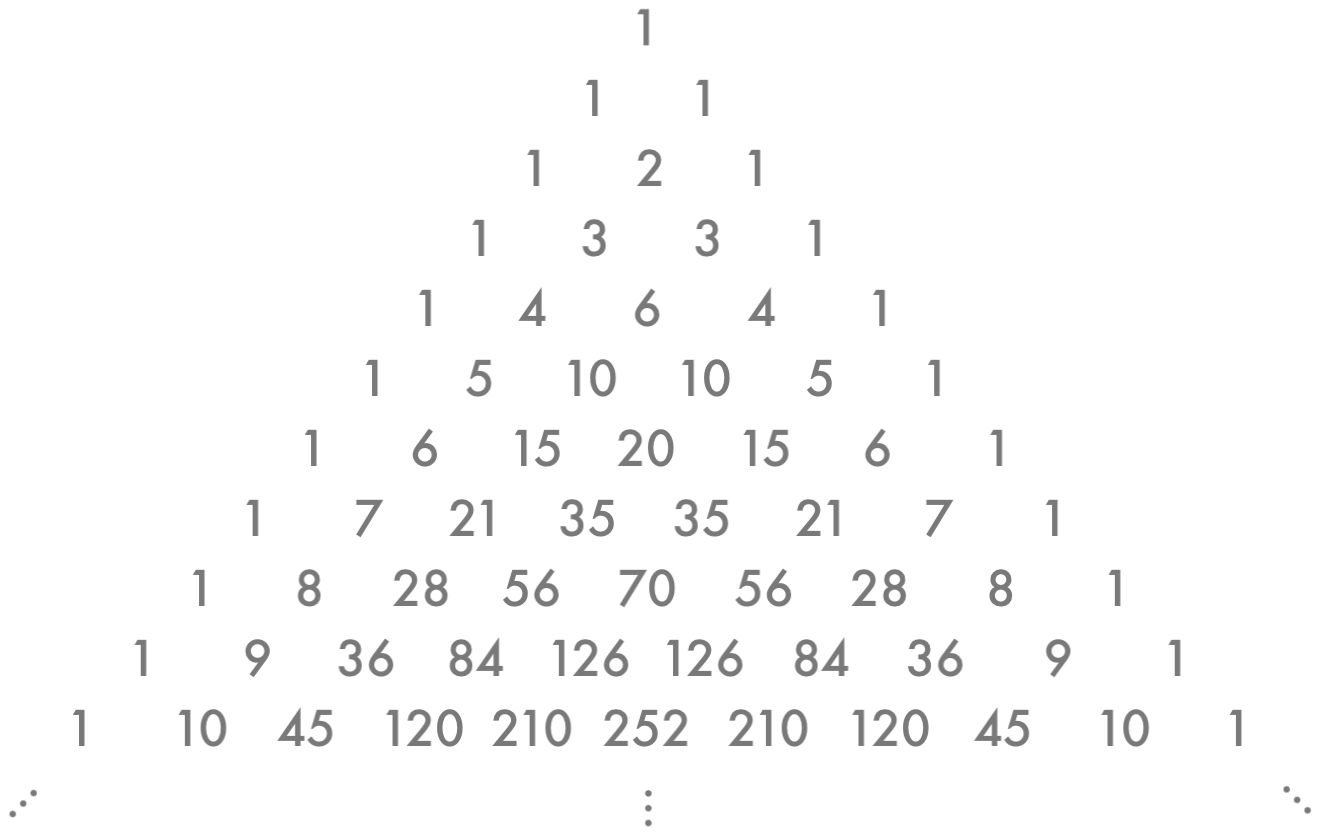我如何修改我的程序,以打印出帕斯卡的三角形?
首先,帕斯卡的三角形看起来是这样的:

你看到的第一行是零第一行。
当你是一名计算机科学家的时候,这没什么不寻常的。
Pascal三角形中的每一个项都可以用公式组合来预测:
C (n,k) = n!/ k *( n )!,其中"n“是行,"k”是从零到n的任意整数。
因此,Pascal三角形可以用(n,k)组合来预测:

这就是你在上图中看到的。
Pascal三角形基本上是二项式概率:
(H + T)^n #你抛出一个双面硬币"n“次,它落在”正面“或”尾巴“上,你用一组系数收集每个硬币的频率,对于n= 3,我们得到展开式:
(H + T)^3 = 1(H^3) + 3(H^2)(T) + 3(H)(T^2) + 1(T^3),其中这些系数: 1,3,3,1位于Pascal三角形的第3行。
我定义了一个阶乘(!)和一个组合,并且能够通过一些循环Perl代码在Pascal三角形的任意行上得到系数数:
use strict;
use warnings;
# Note the first row is row 0.
print("\nWhich row of Pascal's triangle to display: ");
my $row = <STDIN>; # The row that you want to display # This is also n.
my $terms = $row + 1; # The number of terms is one more than the row number.
Pascal_Row($row); # Print the Pascal numbers for that row.
# Function displays the numbers for a row of Pascal's triangle.
#######################################################
sub Pascal_Row
{
my $row = shift; # Row is passed in.
for(my $k = 0; $k < $row + 1; $k++) # k alternates, but not the row which is n.
{
print(combination($row, $k), "\t") # Print each row.
}
print("\n"); # Print a newline after each time this function is called.
}
# This computes the factorial of a number.
###########################################
sub factorial
{
my $number = shift; # argument.
my $factorial_number = 1; # initalize the factorial.
for(my $i = 1; $i <= $number; $i++)
{
$factorial_number *= $i; # compute the factorial, by multiplying all terms up to and including number.
}
return $factorial_number; # Return the factorial number.
}
# Computes a matehmatical combination usually denoted as C(n, k)
# where n is the row number, and k is each item in a row of Pascal's traingle
sub combination
{
my($n, $k) = @_; # from input.
# This is the mathematical formula for a combination.
my $combination_number = factorial($n) / (factorial($k) * factorial($n - $k));
return $combination_number # And returning it.
}如果我运行代码并请求Pascal三角形的第8行,我得到如下信息:
Which row of Pascal's triangle to display: 8
1 8 28 56 70 56 28 8 1帕斯卡三角形的第8行完全是这样。如果我将它从0行循环到Pascal三角形的第8行,我将得到Pascal三角形的所有正确行,但它看起来不像三角形(看起来更像一个框),所以我如何修改代码来调整缩进。
如果要显示Pascal三角形的8行,如何决定缩进第一行的量?我怎么才能做一个“三角形”?
回答 4
Stack Overflow用户
发布于 2017-12-03 06:50:56
这是一个棘手的问题,因为不同的数字宽度对布局很重要。
每一行需要缩进行中数字间隔的一半,适当地乘以(最后一行为零,行为第一行为1) --也就是说,如果数字本身都是相同宽度的。
但情况并非如此,除了前几行;数字占用的空间各不相同。一种解决办法是对数字使用固定宽度,并使用该宽度调整缩进和分离。
首先计算所有行,以便找到数字的最大宽度。
use warnings;
use strict;
use feature 'say';
use List::Util qw(max);
my $max_row = (shift || 8);
my @rows = map { pascal_row($_) } 0..$max_row-1;
my $max_num_wd = max map { length } @{$rows[-1]};
my $pad = 1; # choice (must be non-zero)
my $sep = ' ' x ($max_num_wd + 2*$pad);
my $lead_sp = ' ' x ($max_num_wd + $pad);
for my $n (0..$#rows) {
say $lead_sp x ($max_row-1-$n),
join $sep, map { sprintf "%${max_num_wd}d", $_ } @{$rows[$n]};
}
sub pascal_row {
my ($row) = @_;
return [ map { n_over_k($row, $_) } 0..$row ];
}
sub n_over_k {
my ($n, $k) = @_;
return factorial($n) / (factorial($k) * factorial($n - $k));
}
sub factorial {
my ($n) = @_;
my $fact = 1;
$fact *= $_ for 2..$n;
return $fact;
}这将打印正确的布局。$pad是一个任意整数,用于超过最大数字宽度的额外空间,用于缩进和分离;它必须>0来协调它们。(分离需要上面行中的数字的左和右空间,因此是2的因子。)
原始代码,在计算时打印,因此$max_num_wd是手动设置的。
# (includes and subs same as above except for List::Util)
my $max_row = (shift || 8);
my $max_num_wd = 4; # maximum width of numbers
my $pad = 1; # choice (non-zero)
my $sep = ' ' x ($max_num_wd + 2*$pad);
my $lead_sp = ' ' x ($max_num_wd + $pad);
for my $n (0..$max_row-1) {
my @row = @{ pascal_row($n) };
say $lead_sp x ($max_row-1-$n),
join $sep, map { sprintf "%${max_num_wd}d", $_ } @row;
}这打印一个正确的布局,数字最多4位宽,或$max_num_wd需要调整.
Stack Overflow用户
发布于 2017-12-03 06:42:34
左对角三角形:
my $MAX_VAL_SIZE = 5;
for my $n (0...$N) {
my @row;
for my $k (0..$n) {
push @row, C($n, $k);
}
say join " ", map sprintf("%*d", $MAX_VAL_SIZE, $_), @row;
}中心三角形:
sub center {
my ($n, $s) = @_;
my $pad_len = $n - length($s);
my $pad_len_l = int($pad_len/2);
my $pad_len_r = $pad_len - $pad_len_l;
return ( " " x $pad_len_l ) . $s . ( " " x $pad_len_r );
}
my $MAX_VAL_SIZE = 5;
for my $n (0...$N) {
my @row;
for my $k (0..$n) {
push @row, C($n, $k);
}
my $row = join " ", map center($MAX_VAL_SIZE, $_), @row;
say center(($N+1)*($MAX_VAL_SIZE+2)-2, $row);
}Stack Overflow用户
发布于 2017-12-03 11:46:52
下面是另一种方法:
use strict;
use warnings;
sub fact {
my $n = shift;
return 1 if $n < 1;
return $n * fact($n - 1);
}
sub n_over_k {
my $n = shift;
my $k = shift;
return fact($n) / ( fact($k) * fact($n - $k) );
}
sub pascal_row {
my $n = shift;
return map { n_over_k($n - 1, $_) } (0 .. $n - 1);
}
my $n = shift || 8;
# $maxw is the first odd width where the biggest number will fit
my $max = 0;
map { $max = $_ if $_ > $max } pascal_row($n);
my $maxw = length('' . $max);
$maxw += ($maxw + 1) % 2;
# Print the Pascal´s triangle
foreach my $i (1..$n) {
print ' ' x ( ( $maxw + 1 ) * ($n - $i) / 2 );
foreach my $j ( pascal_row($i) ) {
printf "%${maxw}d ", $j;
}
print "\n";
}怎么做的?在第一个奇数宽度内匹配要打印的数字的最大值。这是因为数字是用空格分隔的,这将使每个宽度成为偶数(对于奇值三角形行,则可以被2除以)。然后使用printf格式化数字。例如,%5d将在5个字符内正确地对齐数字。在每一行前面,除了最后一行外,使用' ' x N生成必要的空格,这将生成一个N空间字符串。
帕斯卡的8三角形:
# pascal.pl 8
1
1 1
1 2 1
1 3 3 1
1 4 6 4 1
1 5 10 10 5 1
1 6 15 20 15 6 1
1 7 21 35 35 21 7 1帕斯卡的13三角形:
# pascal.pl 13
1
1 1
1 2 1
1 3 3 1
1 4 6 4 1
1 5 10 10 5 1
1 6 15 20 15 6 1
1 7 21 35 35 21 7 1
1 8 28 56 70 56 28 8 1
1 9 36 84 126 126 84 36 9 1
1 10 45 120 210 252 210 120 45 10 1
1 11 55 165 330 462 462 330 165 55 11 1
1 12 66 220 495 792 924 792 495 220 66 12 1https://stackoverflow.com/questions/47614514
复制相似问题

